In recent years, public health officials and medical professionals worldwide have come up against increased reluctance and outright rejection of vaccinations. This is despite widespread acceptance of vaccines’ life-saving track-record, robust science, and expert advice from national and multilateral public health institutions. According to the World Health Organization (WHO), vaccination is one of the most cost-effective ways of avoiding preventable disease, and it currently prevents between 2 and 3 million deaths globally each year. Moreover, an additional 1.5 million lives could be saved if global coverage of vaccines was improved. Reluctance or refusal to vaccinate despite the availability of vaccines is known as “vaccine hesitancy”, as described by the WHO, which characterizes vaccine hesitancy as one of the top ten threats to global health in 2019 and directly contributes to an increase in the incidence rate of preventable disease. For example, cases of measles worldwide have increased 30% since 2016, exemplified by news of outbreaks in the Pacific-Northwest, New York, and California in the U.S. Moreover, the Centers for Disease Control (CDC) has reported that the number of confirmed U.S. measles cases in the first five months of 2019 has surpassed the total number of cases per year for the past 25 years. These recent outbreaks contribute to the fact that the United States is in jeopardy of losing its World Health Organization status as a country that has eliminated measles. Amidst the response of public health institutions, major digital platforms like Twitter have responded and launched tools that direct individuals to trusted, credible public health resources when certain keywords associated with vaccines are searched for. Given the rapid speed and immense scale at which digital misinformation and disinformation that contradicts or undermines the knowledge of public health professionals can be diffused, public health officials and medical professionals worldwide have increasingly come up against the tangible realities and repercussions of vaccine hesitancy.
The key insights derived from an analysis of English-language conversations on the topic of vaccines in the public digital sphere can be summarized as follows:
-
- 1. The vast majority of narratives are pro-vaccine, although anti-vaccine narratives propagate extensively given the size of the digital communities that generate anti-vaccine content and messages.
-
- 2. The Anti-Vaxxer digital community is isolated from the other communities, and only a handful of the anti-vaxxer profiles interact with other communities. The digital profiles are closely connected and seemingly coordinated to some degree.
-
- 3. Mistrust in the government and coverups are common narratives by anti-vaxxers, while other arguments link vaccines to autism and injuries, Big Pharma’s profits, the right to choose and censorship, among others (see the full analysis for more details).
-
- 4. Anti-vaxxers use Twitter and Facebook with high frequency to spread messages and engage with other users.
-
- 5. A total of 715 Facebook advertisements were analyzed, of which 139 originated from anti-vaxxers. Anti-vaxxers represent 19.4% of all ads identified, even though the advertisers paying for these ads represent less than a tenth of the total number of advertisers. Thus, each anti-vaxxer advertiser contributes twice as frequently as pro-vaccine advertisers.
-
- 6. The pro-vaccine sponsors spend roughly 50% more per impression on their advertisements compared to the anti-vaxxers. By this measure, anti-vaxxers are more efficient in their investments in Facebook advertising.
- Both anti-vaccine and pro-vaccine ads appear to be focused on young women of birth-giving age. This is the time when decisions on vaccinating children are generally taken.
Scope of Analysis & Key Research Objectives
To better understand key narratives, communities of users and content in the debate around vaccines, Constella’s team of data scientists conducted an in-depth analysis of the public digital conversation on vaccines worldwide in the English language between February 16th and March 18th of 2019. This included an in-depth analysis of paid Facebook advertisements related to the topic of vaccines. Elements of the design of the scope of this project were conducted in collaboration with a Columbia University School of International & Public Affairs student-collaborator undertaking research closely related to the subject matter. This analysis aims to achieve the following goals:
-
- 1. Identify the key narratives and arguments connected with the public digital debate around vaccines
-
- 2. Identify and analyze key communities and influencers in the public digital sphere debate around vaccines
-
- 3. Identify the role and influence of users generating abnormal levels of activity in the debate and analyze the nature of their interactions in order to evaluate the possibility of malicious coordination or influence campaigns
-
- 4. Analyze the key media shared in the public digital sphere conversation in support of the key narratives
- 5. Understand the level of investment and impact of Facebook ads promoting vaccine hesitancy as well as the key organizations and their arguments.
In total, Constella’s analysts indexed and analyzed roughly 1.5 million results from 830,000 authors in 96 countries. These authors interacted in over 61,000 conversations and shared over 72,000 pieces of unique content in relation with the global public digital conversation on vaccines in English, where the U.S. stands for around 41% of results produced, while Canada (4.2%), the UK (4.0%), and Australia (1.5%) also represent significant regions of the conversation. Twitter was identified as the most prominent medium of interaction in the public digital debate where roughly 83% activity has been identified. Facebook and Instagram were also identified as relevant mediums in the conversation around vaccines, responsible for around 9% and 4% of the conversation, respectively. To evaluate the volume of paid advertisements that circulate as content on Facebook related to the public digital conversation on vaccines, Constella’s data scientists analyzed a total of 715 Facebook ads in the United States produced between June 5th,2018 and March 18th, 2019. Out of the total 715 ads, 139 were in support of anti-vaccine narratives.
Pro-vaccines Narratives Dominate the General Conversation
Our team of data scientists used Analyzer, Constella’s proprietary cloud-based analytics platform, to analyze the high-frequency keywords used in public posts by users or in articles by journalists. Our algorithms visually connect these high-frequency terms when they are mentioned simultaneously, or in the body of the same text, by the same users. This method enables unassisted, unbiased identification of key emerging narratives and their complexity and richness through assessing the density of unique terms used within each narrative. This network includes the top 200 most frequent keywords related to vaccines, and these keywords represent 1.32 million total results, equivalent to 91% of the total (1.45 million) results analyzed.
As described, Constella’s analysts clustered the different narratives using AI algorithms that identified the following main narratives in the public digital conversation around vaccines and Anti-vaxxers:
-
- Vaccines & vaccination – 1.15M results (79%): Prominently pro-vaccine conversation around vaccines with conversations around specific incidents involving vaccines such as when an un-vaccinated child started a measles outbreak in Costa Rica. Other arguments include the use of satire, such as @trevordhough saying that Iceland bans unvaccinated kids from the country.
-
- Vaccines work, related to measles – 480K results (33%): Arguments for the importance of vaccines, evidenced by the measles outbreaks across the globe and especially in the U.S. This narrative is largely pro-vaccine as well, poking fun at anti-vaxxers’ lack of logical arguments and the susceptibility of un-vaccinated individuals to diseases such as measles and polio, for example. Another key conversation surrounds an unvaccinated child who got tetanus in the first case in Oregon in 30 years. The child had to spend 57 days in the hospital for a total cost of $800,000, and the child’s parents are still refusing vaccinations.
-
- Vaccinate Your Kid, anti-vaxx and measles outbreaks – 355K results (25%): Conversations around scientific and medical research on vaccinations and recent measles outbreaks, including those in Oregon and New York.
-
- Vaxwoke, and the movie Vaxxed – 149K results (10%): Arguments supporting the anti-vaccine discourse are driven heavily by the documentary, Vaxxed, which aims to highlight the dangers of vaccines based on often uncorroborated individual cases. Arguments invoke unsubstantiated claims, such as one which says a 35-year-old was paralyzed by a flu vaccine without providing well-founded evidence.
-
- Antivaxx – 32K results (2.2%): This narrative heavily refers to a new study on the MMR (measles, mumps, rubella) vaccine. This is the largest study of its kind on the subject, and it concludes that there is no risk of autism from taking the vaccine. Broader discussion on anti-vaxxers in the public eye, such as Canada threatening suspensions over vaccines.
- Vaccinate Dogs in Sarawak – 329K results (23%): Several cases of rabies-infected dogs in Malaysia prompt local announcements on their vaccinations and the vaccinations of residents and international tourists headed to the region.
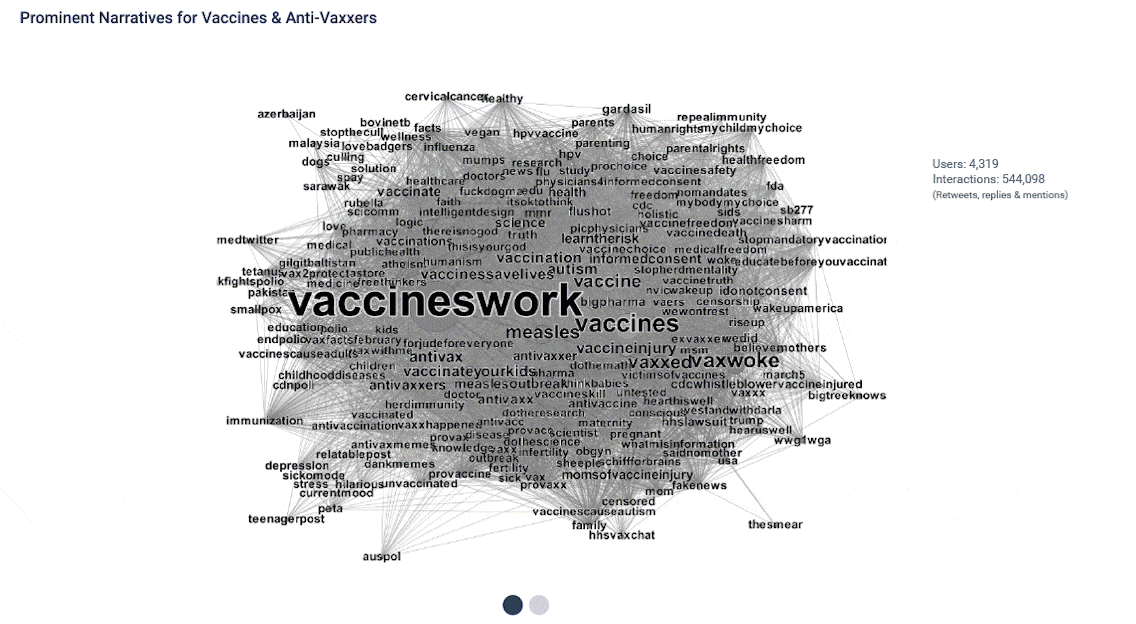
Note that many keywords are common among the narratives, resulting in an aggregated total percentage of results greater than 100%.
Anti-vaxxer Communities Largely Isolated from Pro-vaccine Communities
Constella’s team of data scientists used Analyzer to build and identify the largest communities of users interacting in connection with the public digital conversation on vaccines. This community was identified on Twitter in order to perform a topological analysis of the propagation of their messages across the broader network of users. This resulted in a unimodal network of authors (giant component, edges being interactions). To determine the different communities and visually represent the resulting network, Constella’s data scientists applied clustering algorithms, like the Louvain Method for community detection, for example. Out of a total of 214,936 users and their 593,868 interactions (retweets, replies & mentions), those with zero algorithmic influence across the network were excluded. After filtering out users with no influence, the visualization below reflects a total of 168,594 (78.4%) users generating 475,512 (80.1%) interactions related to the public digital conversation on vaccines.
In order to reach the communities where users spreading messages and content encouraging vaccine hesitation were contributing to different narratives, Constella’s analysts conducted a deep dive into the top 30 communities of opinion interacting in connection with the conversation on vaccines. When assessing the digital communities detected (in ascending numerical order based on the size of each community), the first community whose discourse and interactions could be described as “anti-vaccine” based on their content and messages was community #20 (2.2% of users). Communities #27 and #30 are also partially aligned with anti-vaccine narratives based on the content and messages of the users that interact with high affinity to those communities.

Out of the 30 communities identified and visualized, messages and content related to anti-vaccination discourse are shared frequently in three communities, as indicated. Other communities of users participate in the debate on vaccines by focusing on specific events, cases, or content, through which conversation is subsequently generated. These communities employ a mix of satire and reason to engage with the broader discourse on vaccines and often refute anti-vaxxer claims. Through the generation of new topics and sources of interaction around vaccines, this view allows us to pinpoint and examine the nature of the interactions of each community, the individuals in each community, and the types of content and messages being shared. As noted in the visualization, the largest anti-vaxxer community is isolated from the general network with few interactions or engagement with users in other communities. Some indicators of key elements driving these conversations are highlighted in the visualization above, while sarcasm, humor, and satire are used by both sides as retorts to opposing narratives.
well yeah I didn’t vaccinate my kids, and guess who’s beautiful children will have to live through the coming climate apocalypse? not mine karen that’s for fuckin sure
— roving lounge singer (@KrangTNelson) March 6, 2019
Here we go LOL #measlesoutbreak on #CNN #Fake #Hysteria
The entire Baby Boom population alive today had the #Measles as kids
Bring back our #ChildhoodDiseases they keep you healthy & fight cancer— Darla Shine (@DarlaShine) February 13, 2019
Humor, satire, and sarcasm are frequently employed to introduce and defend narratives in the conversation
Communities Detection Analysis – Deep Dive into Anti-vaxxer Communities
To better understand the communities of users interacting in connection with anti-vaccine content and messages, our analysts used Analyzer to dive deeper into those communities where anti-vaccine content, messages, and discourse were predominantly being generated and shared to identify 4,319 users and their corresponding 544,098 interactions including retweets, replies, and mentions. 7 out of the 8 communities identified belong to closely connected and seemingly coordinated anti-vaxxer profiles, while the mainly pro-vaccine community is more dispersed and on the margins of the core of the anti-vaxxer communities.

-
- 1. Pro-vaccine community (23.3% of interactions)
Mainly pro-vaccine community, referring to the measles outbreak, which originated from unvaccinated children in the Oregon area. The most prominent Twitter account in this community, @screamguitarman, is suspended.
- 1. Pro-vaccine community (23.3% of interactions)
-
- 2. Anti-vaccine community #1 (23.2% of interactions)
Anti-Vaxxer community with @aspiesmom and @delbigtree (Producer of the Vaxxed movie) as prominent profiles. Claims are made that Big Pharma profits off of vaccines and that vaccines cause autism.
- 2. Anti-vaccine community #1 (23.2% of interactions)
-
- 3. Anti-vaccine community #2 (14.6% of interactions)
Anti-Vaxxer community, mainly consisting of @weaponizedword1’s tweet about a girl who got the Gardasil vaccine and, according to him, died because of it. The user is unwilling to provide results from the autopsy when asked. There are several claims that Merck manipulated the vaccine’s safety data.
- 3. Anti-vaccine community #2 (14.6% of interactions)
-
- 4. Anti-vaccine community #3 (14.5% of interactions)
Anti-Vaxxers (organizations and authors, among others) question the safety of vaccines, the science behind vaccines, mandatory vaccines, and Big Pharma’s profits. There are claims that death by vaccines are greater than the diseases they are intended to prevent.
- 4. Anti-vaccine community #3 (14.5% of interactions)
-
- 5. Anti-vaccine community #4 (8.8% of interactions)
Anti-vaxxer community with several individuals and organizations claiming that kids get sick after vaccinations. Big Pharma’s high profits and tech companies’ so-called censorship of misinformation are other topics.
- 5. Anti-vaccine community #4 (8.8% of interactions)
-
- 6. Anti-vaccine community #5 (6.3% of interactions)
Anti-Vaxxers community where authors @forrestmaready and @eileeniorio are prominent figures. Trust, fake news, the $4 billion paid out for vaccine injuries, and questionable studies that link vaccines to autism are prominent narratives, most notably, Andrew Wakefield, M.D.’s, now retracted 1998 publication in the Lancet which famously linked vaccines with autism.
- 6. Anti-vaccine community #5 (6.3% of interactions)
-
- 7. Anti-vaccine community #6 (3.8% of interactions)
The main anti-vaxxer profile is @crwriter1. Arguments span from dangerous vaccine ingredients, the number of vaccines given, pregnancy issues, and insufficient safety data. One ingredient that has been studied is thimerosal, for example. Thimerosal is a mercury-based preservative used to prevent contamination of multidose vials of vaccines, and research by the CDC and other public health institutions do not corroborate a link between thimerosal and autism. Still, the CDC states that most vaccines contain neither thimerosal nor mercury.
- 7. Anti-vaccine community #6 (3.8% of interactions)
- 8. Mixed community #1 (3.2% of interactions)
A mixed community consisting of news media, journalists and politicians. Main narratives are tetanus and measles cases, denying unvaccinated children access to school, “bad information” and anti-vaxxers as a national threat.
Anti-vaxxers Frequently Interact with and Mention Each Other
In evaluating possible coordination among users interacting in connection with communities generating anti-vaxxer messages, our analysts mapped the volume and distribution of retweets, replies, and mentions across the communities where anti-vaxxer users and content were predominantly active. The number of retweets and replies are roughly the same within the anti-vaxxer communities, with 257,881 retweets and 251,655 replies generated by 349 and 209 profiles, respectively. That’s an average of around 833 interactions per profile during the period, or 28 per day. Mentions among the anti-vaxxers are considerably greater, with over 1,100 users generating above 400,000 mentions. This elevated rate of mentions could possibly be due to coordination among anti-vaxxer profiles generating content, messages, and interactions. These frequent interactions could plausibly be a method of amplifying the niche messages and limited volume of users producing content and messages in support of the anti-vaxxer discourse.
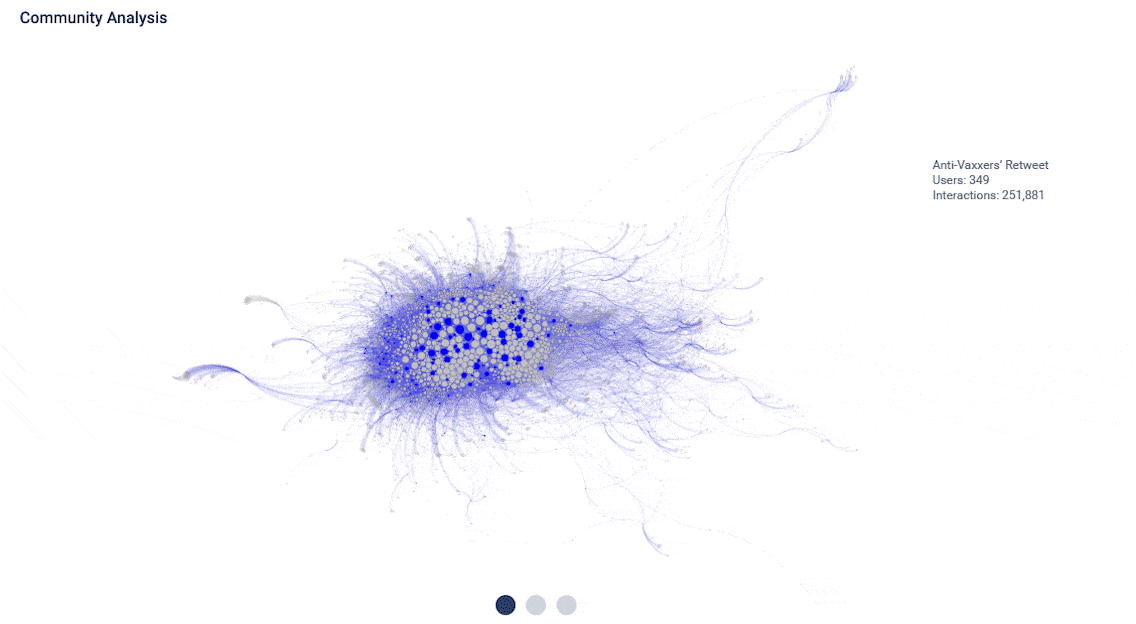
Analysis of Abnormal High Activity Users in Anti-Vaccine Communities
To determine if users demonstrating abnormal levels of activity participated in the debate, Constella’s team conducted an analysis of outliers in the anti-vaccine communities in order to assess their frequency of posting. Constella’s analysts identified 26 (0.015%) users interacting with the highest frequency in the debate. These users produced a total of 13,133 (2.8% of total posts) posts over the period of analysis with a maximum of up to 42 posts per day on average. The three most active profiles, @ 9_11_isaninside and @ sarah_q_smithy produced 1,251 and 1,232 posts over the period analyzed, respectively. This is equivalent to 42, 41 and 33 per day, indicating possible evidence of non-human assisted automation in propagating public content and messages supportive of anti-vaxxer narratives.
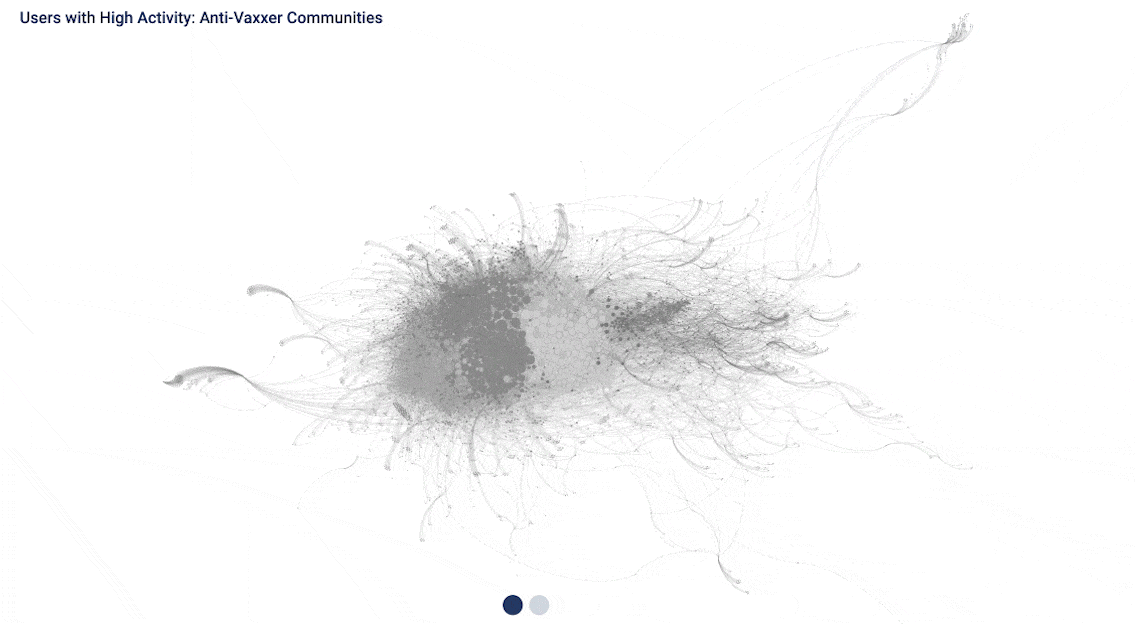
Analysis of Most Relevant Media
To determine which media sites are most influential, Constella’s algorithms consider the number of users and the volume and frequency of links from media sites being shared across social media sources to calculate how influential the site is within the context of the analysis. Constella’s software ranks content influence similar to Google’s algorithms for web page ranking – the content from more relevant sites are likely to receive greater attention from more users over a sustained period of time. Below, see the 50 most relevant domains shared in both the general conversation and in the anti-vaccine communities. Key findings include:
– Traditional media sites and content-sharing platforms such as the New York Times, The Guardian, CNN, BBC, The Washington Post, Twitter, YouTube, Facebook, and others were among the most shared in the general conversation on vaccines, indicating the relevance of traditional and established media and content-sharing platforms in the debate. Pages of public health institutions such as the Centers for Disease Control (cdc.gov), the National Institute of Health (nih.gov), and the World Health Organization (who.int) are also shared with high frequency, in many cases reinforcing the conclusions reached in the communications of these public bodies on vaccines and health risks around vaccine hesitation.
– In analyzing the most shared media within the communities of users interacting in connection with anti-vaccine discourse, official government sites such as whitehouse.gov, nih.gov, and cdc.gov appear among the most shared. This is likely due to “reframing”, or the sharing of media and content with an opposing message to further illustrate or emphasize a certain position. Among anti-vaxxer communities, it is important to note media such as vaccineimpact.com, thevaccinereaction.org, childrenshealthdefense.org, and healthimpactnews.com, among several others, offer a narrative of “alternative”, skeptical media or organizations which challenge the assumptions of mainstream media and government recommendations.
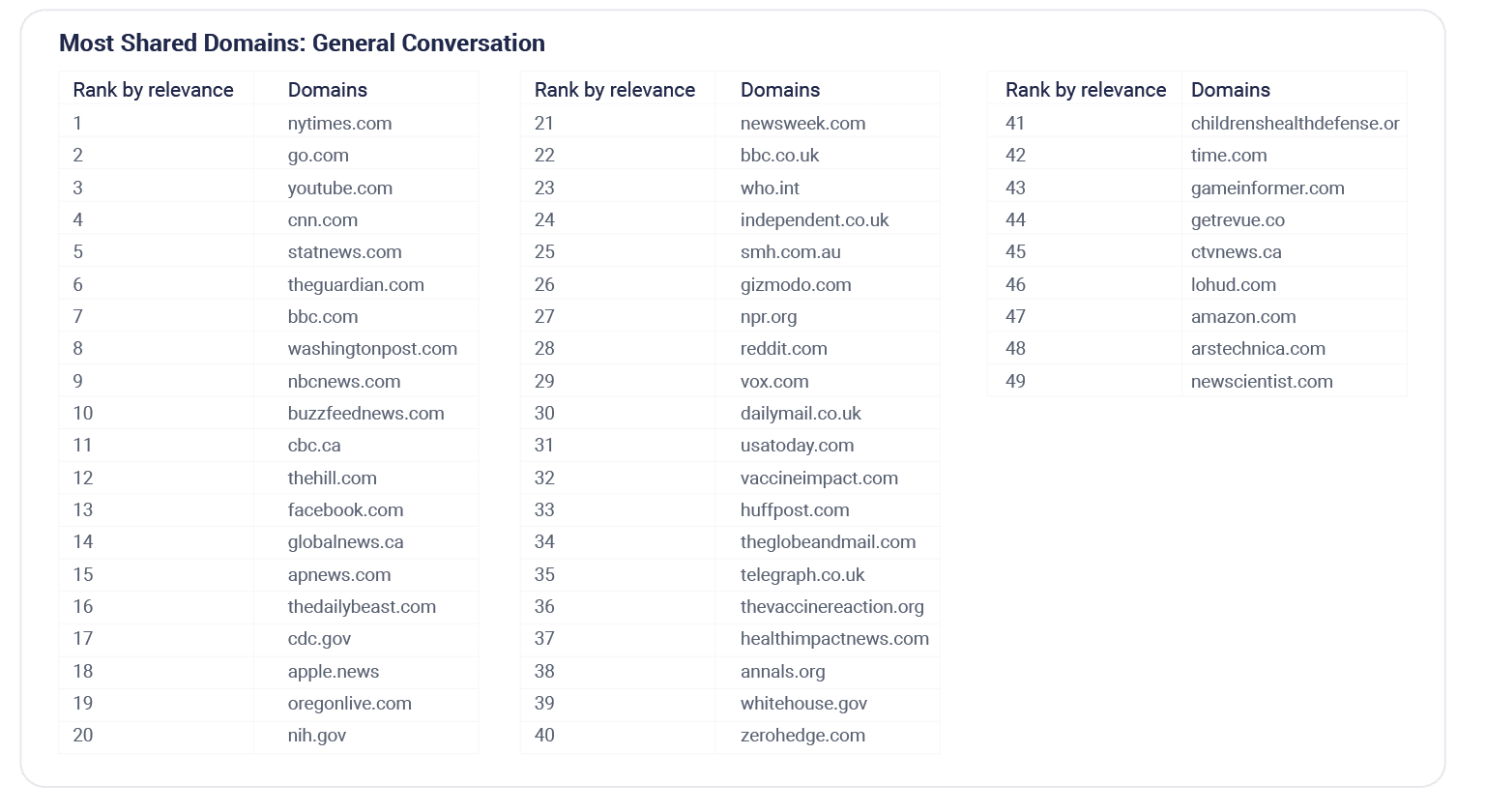
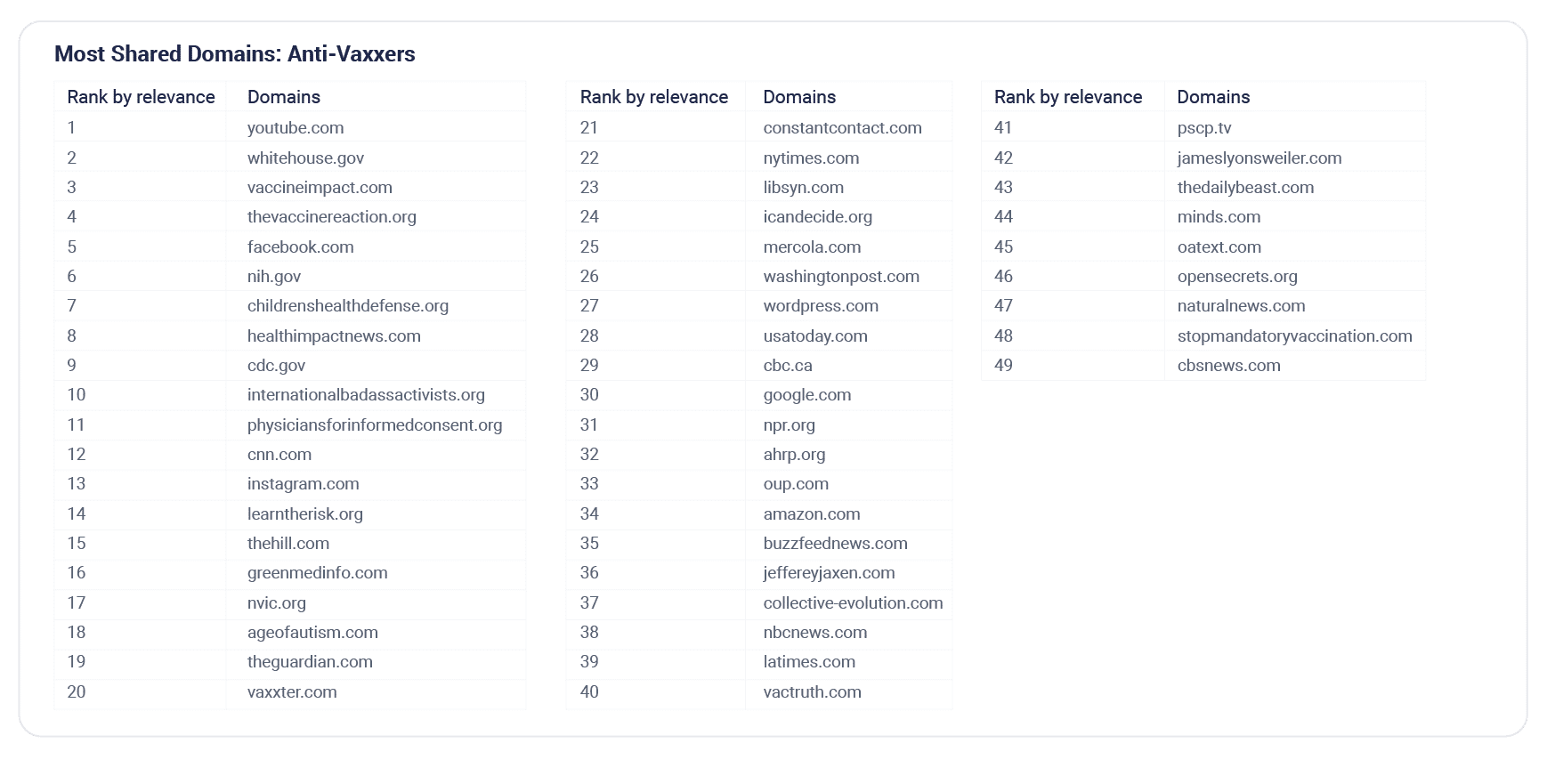
Anti-vaccine Advertisers More Effective at Achieving Impressions
To evaluate the volume of paid advertisements that circulate as content on Facebook related to the public digital conversation on vaccines, Constella’s data scientists analyzed a total of 715 Facebook ads in the United States produced between June 5th,2018 and March 18th, 2019. Out of the total 715 ads, 139 were in support of anti-vaccine narratives. The following are key insights derived from the analysis of sponsored, or paid Facebook ads:
– Anti-Vaxxers represent 19.4% of total paid ads during the period analyzed, even though anti-vaccine sponsors only made up 8.5% of the total number of sponsors. Therefore, in terms of the volume of advertisements, each anti-vaccine sponsor contributes more than twice as many advertisements as pro-vaccine sponsors.
– The pro-vaccine sponsors spend roughly 50% more per impression on their advertisements compared to the Anti-Vaxxers, considering both min- and max number of impressions. Anti-Vaxxers are thus more efficient in their ratio of investment per impression achieved.
– Although anti-vaccine advertisers achieve a higher return on their investment, 154 pro-vaccine advertisers significantly outnumber only 14 anti-vaccine advertisers.
– Texas, California, Michigan, and Wisconsin appear to have been mainly targeted by pro-vaccine ads while Texas, California, Michigan, and Washington appear to have been the main targets of anti-vaxxers.
– The top anti-vaxxer sponsors in terms of maximum impressions were the World Mercury Project (2.6M), Larry Cook (1.4M) and Michigan for Vaccine Choice (374K).
– Overall, the same key narratives are pushed as on Twitter, focusing on vaccine health hazards such as autism, paralysis and allergies, Big Pharma’s profit incentives and coverups, as well as the right to choose.

Advertiser Categorization
The principal advertisers in both camps in terms of maximum impressions and maximum investment are non-profit organizations such as the World Mercury Project, political organizations like the House Democratic Campaign Committee, and individuals such as Larry Cook. These categories are defined by Facebook and reflect Facebook’s internal classification criteria.

Strategic Demographic Targeting
Based on the demographic distribution of impressions achieved, both anti-vaccine and pro-vaccine ads appear to be targeted towards young women in their birth-giving ages based on the total number of impressions achieved per demographic categorization. This is the period when decision-making regarding vaccination of children is immediate and relevant. Consequently, fewer ad impressions are achieved with younger demographics and males, likely as a result of ad segmentation and targeting.
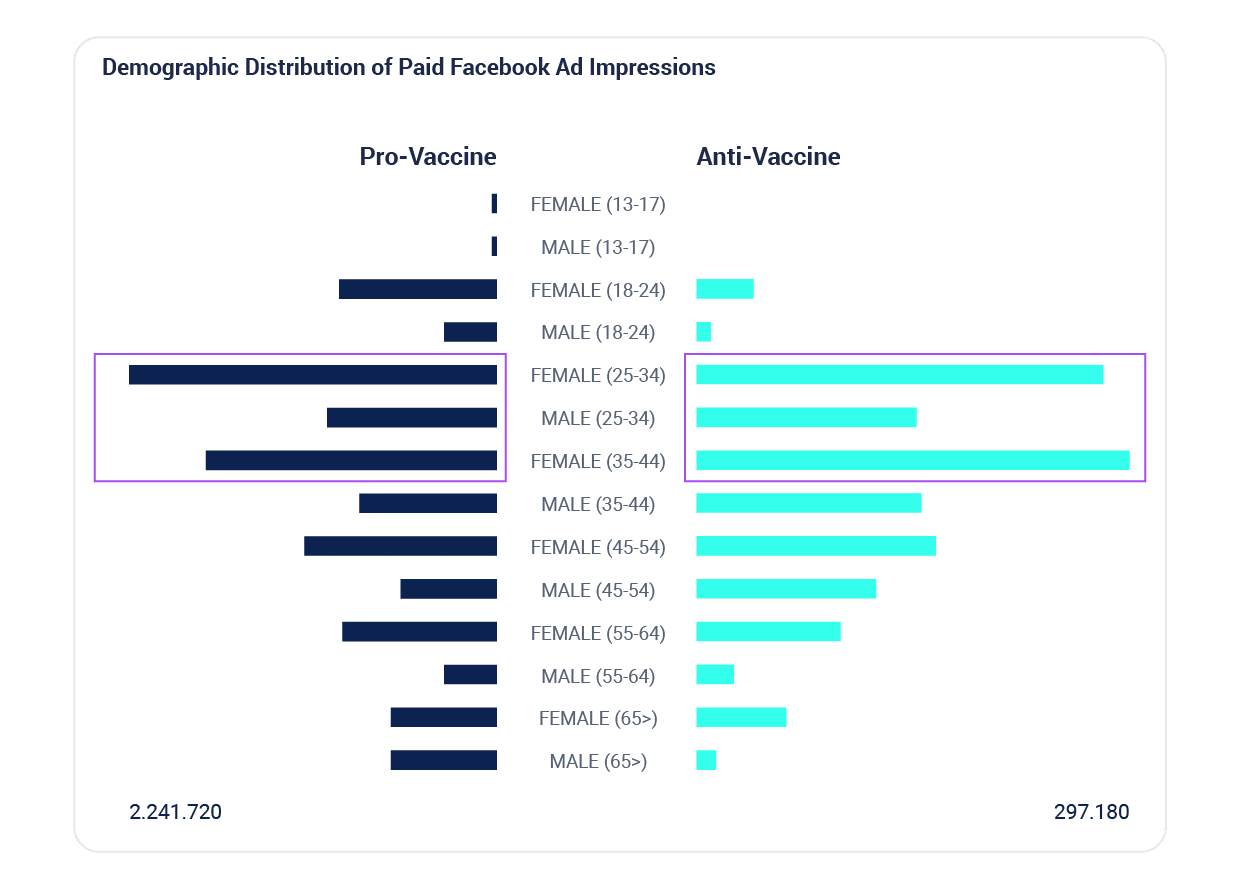
Most Frequently Employed Anti-Vaxxer Arguments
In a thorough analysis of the global public digital conversation across a wide range of platforms, content, and conversations, the following arguments have been identified by our analysts as those most frequently used by anti-vaxxers. By scrolling over the text below and clicking, an example of content or messaging embodying each argument can be accessed.
- 11. Mothers know their children better than the “corrupt” pharma industry and doctors (reference videos have been removed since the original publishing of this article).
Conclusions and Further Research
After detailed research and analysis of the public digital conversation related to vaccines, Constella’s research supports the conclusion that although pro-vaccine narratives are significantly more prominent in terms of total volume, anti-vaxxer users are successful at propagating content and diffusing anti-vaxxer narratives throughout the public digital sphere. Some of the key points from the analysis are abridged below:
1. Out of the communities of users that our analysis identified, the Anti-Vaxxer digital community (meaning that the users in this community are interacting with users and media generating narratives that are primarily anti-vaccine in nature) is isolated from the other communities, and only a handful of the anti-vaxxer profiles interact with other communities. The anti-vaxxer digital profiles are closely connected and seemingly coordinated to some degree given their isolation from the general conversation.
2. Common narratives by anti-vaxxers are rather diverse, but many of them focus on mistrust in the government and alleged coverups, safety concerns supported by linking vaccines to autism and injuries, Big Pharma’s profits, and the right to choose and censorship, although there are several others exemplified in the analysis.
3. Anti-vaxxers represent roughly 20% of all Facebook ads identified in our analysis, even though the advertisers paying for these ads represent less than a tenth of the total number of advertisers. Thus, each anti-vaxxer advertiser contributes roughly twice as frequently as pro-vaccine advertisers. Moreover, pro-vaccine sponsors spend roughly 50% more per impression on their Facebook advertisements compared to the anti-vaxxers. By this measure, anti-vaxxers are more efficient in their investments in Facebook advertising.
4. Both anti-vaccine and pro-vaccine ads appear to be focused on young women of birth-giving age. This is the time when decisions on vaccinating children are generally made.
Without a doubt, the most effective and holistic strategy to counter vaccine disinformation involves long-term robust, multistakeholder collaboration to employ proactive and dynamic strategies that build trust and engage the technology platforms themselves, media, academia, public institutions, and companies. To a certain degree, public health institutions and technology platforms have made some headway in this regard, although the incredibly powerful segmentation capabilities of platforms like Facebook should be reconsidered in light of the demonstrated abilities of microtargeting and amplification of messages through detailed techniques. When these matters become issues of public health and safety, disinformation that is not reined in by technology platforms can have an undermining effect on public health institutions and their ability to carry out their jobs effectively. It is critical that the production of veracious content exists alongside proactive multistakeholder initiatives that involve participation and solution-building from technology platforms, the public sector, academia, companies, and the media to address the erosion of trust and credibility that fuels much of the polarization and the success of mis- and disinformation content in the digital sphere related to public health matters such as vaccines.
Article written by Jonathan Nelson. Originally published on Jan. 20, 2020
Interested in our work? Please contact us at info@constellaintelligence.com. To learn more about Constella, subscribe to our newsletter below.











